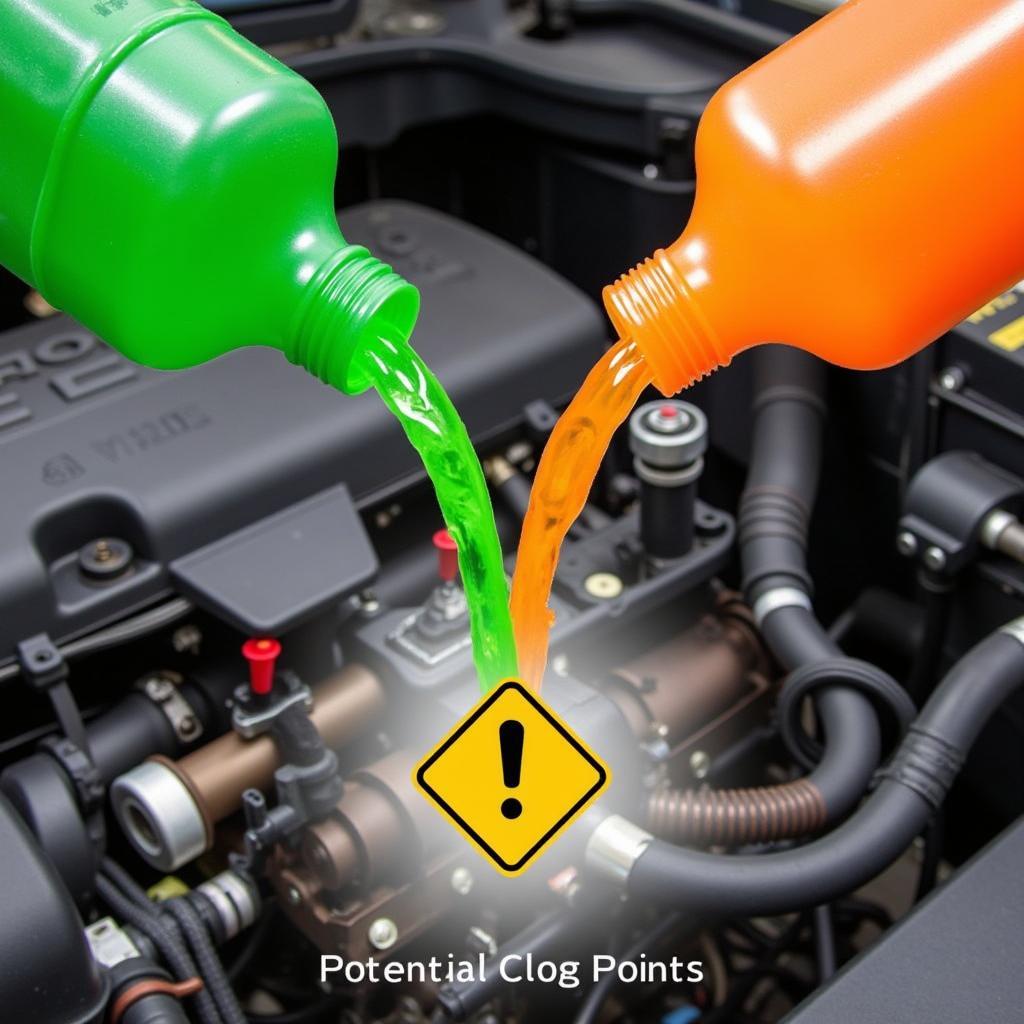Antifreeze, the essential fluid that keeps your engine running smoothly in both scorching summers and frigid winters, often comes in a rainbow of colors. This can lead to a common question: Can You Mix Different Colored Antifreeze? The answer, while seemingly simple, requires a deeper understanding of antifreeze chemistry and the potential implications of mixing different types.
Understanding the various antifreeze types is crucial for maintaining your vehicle’s cooling system. While color can be a helpful indicator, it’s not the definitive factor. The chemical composition is what truly matters. Mixing incompatible antifreezes can lead to a sludge-like substance that can clog your cooling system, potentially causing overheating and costly repairs.
Decoding the Antifreeze Rainbow: What Do the Colors Mean?
Antifreeze color isn’t standardized. Manufacturers use different dyes, leading to a variety of hues for essentially the same type of coolant. While green was traditionally associated with IAT (Inorganic Additive Technology), you might now find IAT coolants in other colors like orange or yellow. OAT (Organic Acid Technology) coolants are typically orange, yellow, or red, while HOAT (Hybrid Organic Acid Technology) coolants can be found in colors like pink, purple, or blue. Don’t rely solely on color! Always consult your vehicle’s owner’s manual for the recommended antifreeze type.
 Mixing different antifreeze colors can be risky
Mixing different antifreeze colors can be risky
Why Mixing the Wrong Antifreezes Can Be Problematic
Mixing different antifreeze technologies can have detrimental effects on your car’s cooling system. IAT, OAT, and HOAT coolants contain different additives designed for specific purposes. Mixing them can neutralize these additives, reducing their effectiveness and potentially leading to corrosion, rust, and the formation of harmful deposits. These deposits can clog the narrow passages of your cooling system, hindering its ability to regulate engine temperature.
Is it Safe to Top Off with a Different Color?
Topping off your coolant is sometimes necessary, but using the wrong type, even in small amounts, can create issues over time. While a small amount of a different type might not cause immediate damage, it can compromise the long-term protection offered by your original coolant. If you absolutely must top off with a different color, distilled water is the safest option. However, it’s crucial to flush the system and replace it with the correct coolant as soon as possible.
What If I Accidentally Mixed Coolants?
If you’ve accidentally mixed antifreezes, it’s recommended to flush your cooling system thoroughly and refill it with the manufacturer-recommended coolant. This will remove any potentially harmful mixtures and ensure your cooling system operates efficiently. Ignoring a mixing incident could lead to significant problems down the line.
does color of antifreeze matter
Identifying the Right Antifreeze for Your Car
The most reliable way to determine the correct antifreeze is to consult your vehicle’s owner’s manual. It will specify the recommended type and color. You can also check for labels or stickers under the hood that might indicate the type of coolant already in the system. If you’re still unsure, a mechanic can help you identify the correct type for your vehicle.
Long-Term Effects of Mixing Incompatible Antifreezes
In the long term, mixing incompatible coolants can lead to expensive repairs. Clogged radiators, water pump failure, and even engine damage can result from neglecting this crucial aspect of car maintenance. Regularly checking and maintaining your coolant system with the correct antifreeze will ensure optimal performance and prevent costly issues.
is it bad to mix coolant colors
Expert Insights: John Miller, Automotive Engineer
“Color is not a reliable indicator of antifreeze compatibility. Always prioritize the chemical composition, as indicated in your owner’s manual. Mixing incompatible types can lead to a gummy residue that clogs the system and compromises heat transfer.”
Expert Insights: Sarah Chen, Automotive Chemist
“The different additive packages in IAT, OAT, and HOAT coolants are designed for specific metal types and operating conditions. Mixing them can neutralize these protective properties, leading to corrosion and premature component failure.”
does it matter if you mix coolant colors
what color antifreeze for ford f150
In conclusion, mixing different colored antifreezes can be risky unless they are of the same chemical composition. Always refer to your owner’s manual for the recommended antifreeze type and avoid relying solely on color. Regular maintenance and using the correct coolant will protect your engine and prevent costly repairs.
FAQ
- What is the main difference between IAT, OAT, and HOAT antifreeze?
- Can I use universal antifreeze in my car?
- How often should I change my antifreeze?
- What should I do if I spill antifreeze?
- What are the signs of a failing cooling system?
- Can I mix antifreeze with water?
- How do I dispose of used antifreeze?
Need Help? Contact Us!
Phone: 0373298888
Email: [email protected]
Address: 86 Cau Giay, Hanoi
We have a 24/7 customer service team available to assist you.